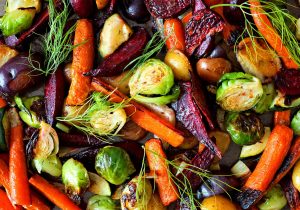
The vitality of vegetables
Whether you love them, like them, or leave them off your plate, there’s no denying that vegetables are a part of a healthy diet. Along with serving up a hearty helping of vitamins and minerals, vegetables add a burst of flavor, freshness, sweetness, crunch, and variety to any meal. If you’re fed up with eating the same-old veggies or don’t like their texture or taste, it’s time to turn over a new leaf by discovering the bounty of different varieties and their range of flavors and nutrients. Then see why your parents always told you to eat your vegetables by learning about the benefits they bring to the table, along with how much you really need to meet your body’s needs. So, whether you’re trying to eat healthier or freshen up your diet, get a taste of all of the goodness that’s growing in the garden.
A garden variety of vegetables
Part of the beauty of the bounty in the garden is the rainbow of veggie varieties, with picks for each person and preference. There are many kinds of vegetables, with just as many ways to prepare and enjoy them. While vegetables are delicious eaten raw with their natural crunch and freshness, you can enhance their taste and texture by baking or roasting to bring out their sweetness, grilling to add smoky flavor, mixing them into your favorite dishes and drinks, stir frying or air frying for a crispy bite, or dressing them up with sauces and spices. If you’re overwhelmed by the number of stalks, sprouts, and spuds available at the market, it helps to understand that there are just five groups of vegetables, divided by their colors and nutrients. The five garden-fresh groups of veggies include:
- Dark green vegetables – Go green by choosing broccoli, spinach, kale, leafy lettuce, bok choy, and Swiss chard. These greens are go-tos for fiber, iron, potassium, and vitamins A, C, E, and K.
- Red and orange produce – Fresh favorites range from red bell peppers, beets, and tomatoes to carrots and winter squash. They’re full of potassium, along with vitamins A, C, and K.
- Legumes – Look for lentils and edamame, along with beans from black and white to pinto and garbanzo. They are packed with plant protein, plus B vitamins, iron, and fiber.
- Starchy veggies – Both hearty and healthy, starchy standouts include white potatoes, sweet potatoes, corn, and green peas. They add a punch of potassium, B vitamins, fiber, and vitamin C.
- Other fresh picks – This colorful collection of veggies doesn’t fit into any of the other groups, but still adds a variety of colors, tastes, textures, and nutrients to your diet. These include artichokes, eggplant, and cauliflower to Brussels sprouts, garlic, and onions that are brimming with vitamins, along with fiber and minerals.
Root out the benefits of eating vegetables
Veggies are full of antioxidants, vitamins, and minerals. Since they’re also low in fat and calories yet high in filling fiber, they can help you feel full for hours without filling you out! And all of their essential nutrients may help improve your health and lower your risk of many diseases. Eating a colorful variety of vegetables can benefit your body, mind, and overall health in the following ways:
- Keeps your immune system strong.
- Helps your heart by reducing your risk of cardiovascular disease.
- May reduce your risk of several kinds of cancer.
- Can help lower your blood pressure.
- Protects your body from inflammation, which can cause many diseases.
- Increases your intake of fiber to help you manage your hunger and weight.
- Helps keep your brain focused and sharp.
- Balances out blood sugar levels.
- Protects your vision.
An update on a healthy intake
Even if you love eating vegetables, you may be a little green on how much you need each day. Unfortunately, most Americans of all ages (not only picky kids!) aren’t eating enough veggies. Experts recommend consuming two to four servings of vegetables each day based on your age, weight, height, sex, and level of physical activity. Ask your SignatureMD-affiliated doctor about your individual needs. However, not all servings are created equal. A serving of veggies is considered one cup of raw or cooked vegetables, one cup of vegetable juice, or two cups of leafy salad greens. But regardless of whether you eat your veggies fresh, frozen, dried, canned, whole, mashed or juiced, they all count toward your daily dose of needed nutrients and fresh flavor.
By branching out and eating a variety of vegetables prepared in different ways, you’ll be able to get the nutrients you need to sow the seeds of good health.